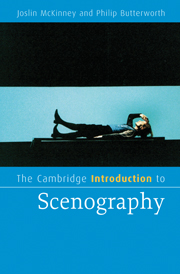Book contents
- Frontmatter
- Contents
- List of illustrations
- List of boxed quotations
- Preface
- Acknowledgements
- Part 1 Elements
- Part 2 Processes of scenography
- Chapter 3 Text as conditioner of image
- Chapter 4 Recognising and realising space
- Chapter 5 Technology as performance
- Part 3 Realisation and reception
- Notes
- Bibliography
- Index
- Cambridge Introductions to …
Chapter 5 - Technology as performance
Published online by Cambridge University Press: 05 February 2015
- Frontmatter
- Contents
- List of illustrations
- List of boxed quotations
- Preface
- Acknowledgements
- Part 1 Elements
- Part 2 Processes of scenography
- Chapter 3 Text as conditioner of image
- Chapter 4 Recognising and realising space
- Chapter 5 Technology as performance
- Part 3 Realisation and reception
- Notes
- Bibliography
- Index
- Cambridge Introductions to …
Summary
Throughout the history of Western theatrical presentation, technology has been used to captivate and astound audiences. Early theatre such as that of the Greeks and Romans made use of available technology in order to produce visual transformations, interventions and spectacle. Although later European medieval theatre put stress on the need for audiences to hear and listen to plays, there was also considerable emphasis on the spectacular in performance. For example, staging features such as the medieval device known as Hell Mouth, in which devils and damned souls could appear and disappear through the gaping jaws of a bear's or bull's head, made use of opening and closing doors, lifted jaws or curtains to cover the opening of the mouth. Devils appeared to be consumed by flame.
A powerful example of the way in which aspects of early technology coalesced, and still do so in performances today, is the Misteri d'Elx which began in the fifteenth century and is still performed on 15 August every year at Elche, Spain. Here, in the Basilica de Santa Maria, community actors and singers perform a representation of The Assumption of the Virgin where scenography provides a key visual focus and simple technology transforms the basilica. Three skeletal metal frames suspended on three thick hemp ropes are separately lowered and raised through a trap door in the dome of the basilica. From here to ground level is some 130 feet. One of the frames is known as the mangrana, or the ‘pomegranate’.
Information
- Type
- Chapter
- Information
- The Cambridge Introduction to Scenography , pp. 126 - 148Publisher: Cambridge University PressPrint publication year: 2009
